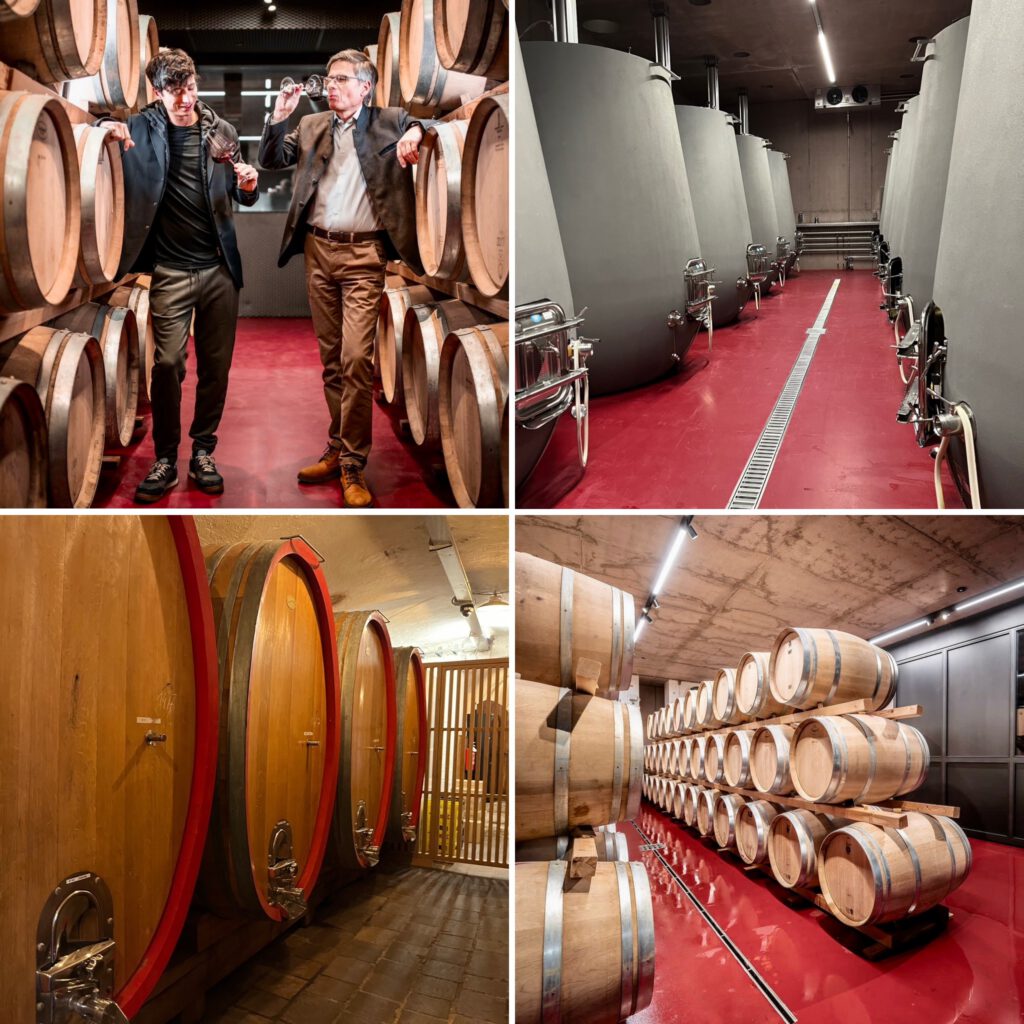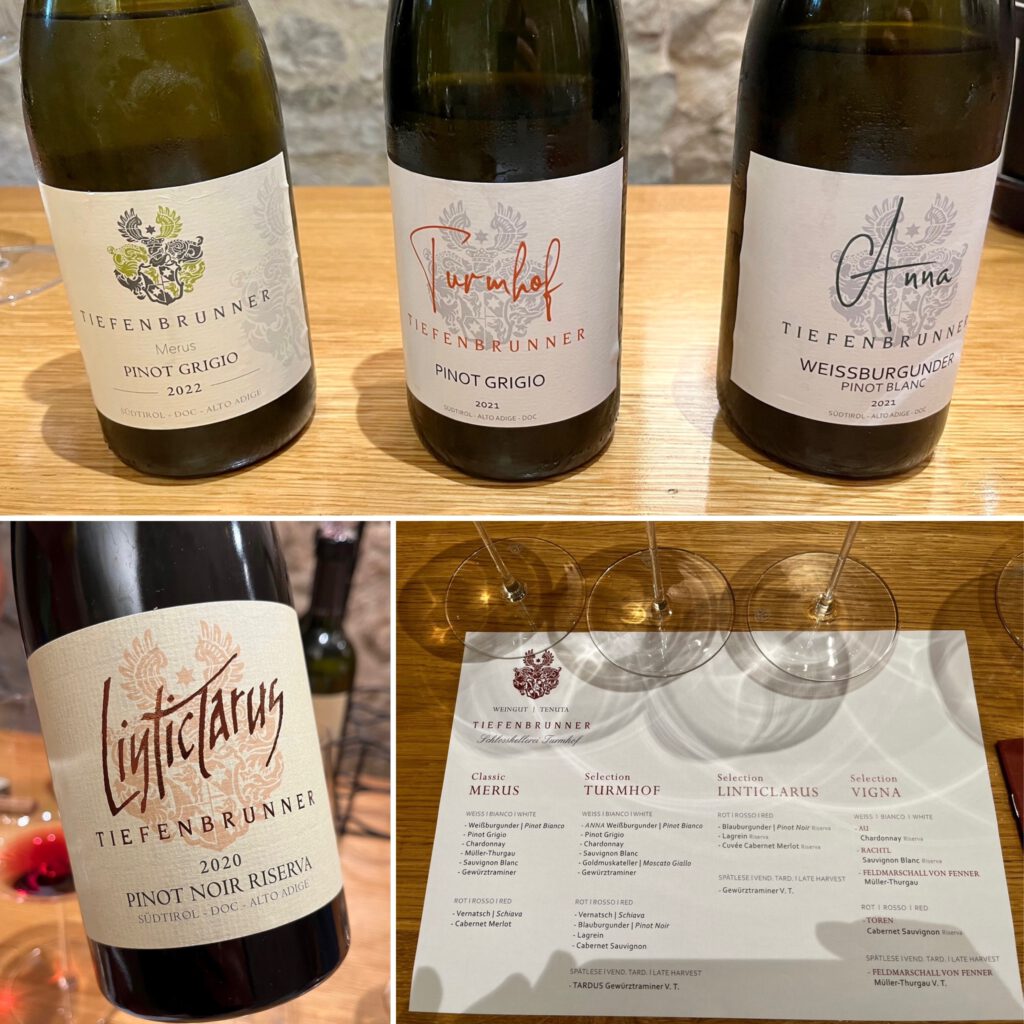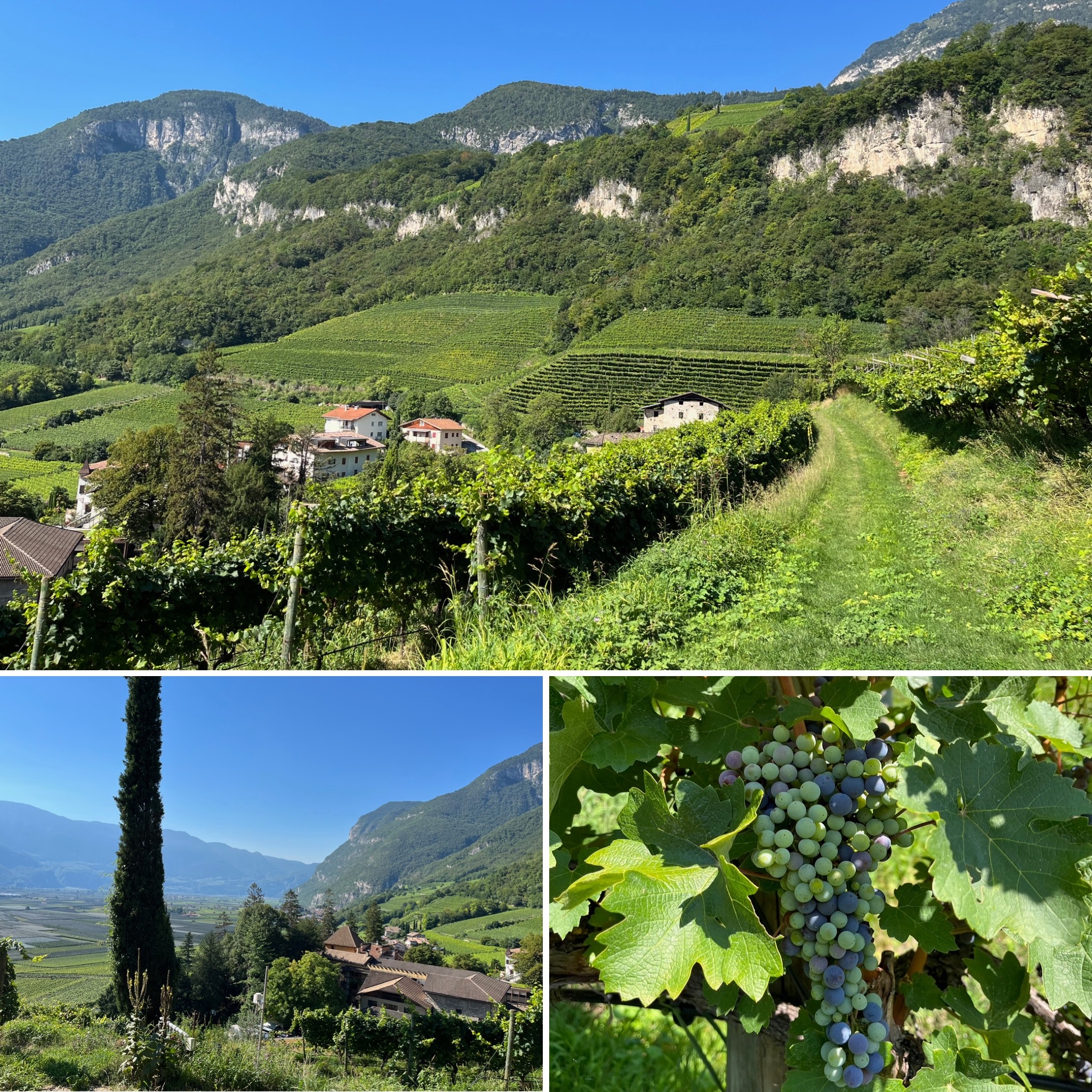Tiefenbrunner – A Blend of Austrian Purity and Italian Passion.
A warm summer morning in northern Italy. It is a hive of activity between the steep rock walls on both sides of the valley floor. Apple harvest has begun. We leave the fuss behind as we take a turn into the hills. The country roads are getting smaller, steeper and curvier. Just when we are about to turn around, we drive into a cosy treelined country yard. A pastel coloured medieval castle with beautiful wall paintings loom up, surrounded by vines, trees and cypresses. Mythical and biblical sculptures around a calm pond witness a sense of history. We have arrived in a haven of peace, Schlosskellerei Turmhof, the home of Weingut Tiefenbrunner.
Alto Adige: Best of Two Worlds
“Herzlich Wilkommen bei Schlosskellerei Turmhof’. Tailored jeans, black polo shirt, honest smile and a warm handshake. Christof Tiefenbrunner speaks with confidence and calm. Talking German in Italy was the last to expect, but is not as strange as it seems. Alto Adige is located in northern Italy, close to the Austrian border. Alto Adige (in German: Süd Tirol) has been part of Austria for a long time. Although Alto Adige now belongs to Italy, residents identify themselves as Tyrolean. German is their main language and Italian is taught as a second language. This bilingualism is not only shown in road signs: wine labels often do mention both German and Italian names. Alto Adige offers the best of two worlds. Maybe the best example is the city of Bolzano (Bozen). This beautiful province capital combines Saxon cleanliness with Latin charm. It shows Austrian purity with Italian passion and flair. This exciting combination is also reflected in the wines of Alto Adige.
Best of Two Climates
To see how that works out, Christof Tiefenbrunner takes us into the vineyards. It is obvious that his soul lays in here. During the firm hike he takes a break every two steps to explain a thing or two. It is a stiff climb: the better vineyards are located on greater hights. Tiefenbrunner explains most of his vineyards are located in the southern part of Alto Adige, close to the border with Trentino. Day temperatures in Alto Adige can be quite high and in the south temperatures are even slightly higher. Altitude and location of the vineyards do play a determining role. At greater hights the diurnal range is higher, resulting in preservation of natural freshness and grape own aromas. According to Tiefenbrunner, the climate in Alto Adige up to 500 meters a.s.l. can be regarded as Mediterranean, whereas above 500 meters the climate qualifies as alpine. Tiefenbrunner: ‘These circumstances do give us the unique opportunity to play with both worlds. We literally are equipped with the best of two worlds.’
Solid foundation
Christof and Sabine Tiefenbrunner do represent the fifth generation to run the winery. Tiefenbrunner owns approximately 25 hectares of vineyards in different locations, at elevations ranging from 210 to 1.000 meters above sea level. In addition to that, they do buy grapes from 58 small-scale winegrowers. In Alto Adige production models with non-producing growers are common use. Cooperatives are responsible for 70% of Alto Adige’s wine production. Most of these cooperatives are known for their exceptional high-quality wines.
Uncompromising equipment
Integrated in the landscape and architectonic adopted to the old castle, the underground wine cellar is one of a kind. A well thought out and highly automated modern cellar is at winemaker’s Stephan Rohregger disposal. In the wine cellar the large concrete fermentation vats are hard to miss. Almost all of the wines undergo fermentation in these tulip shaped concrete vessels. Just like in wood, in concrete micro-oxidation can take place, contributing to softer extractions and lowering the risk of reduction. The concrete vessels are equipped with fully automatic pedals. When it comes to extraction, Tiefenbrunner strives gentleness. Christof Tiefenbrunner: ‘I just don’t like harsh tannins.’ Well, we do not see how to argue with that.

About the Wines
In Alto Adige one can find a wide range of wines from international grape varieties such as Weissburgunder (Pinot Blanc) and Blauburgunder (Pinot Noir), as well as native varieties as Vernatsch (Sciava) and Lagrein. Tiefenbrunner produces both white and red wines, but their main focus is on the whites.
The wines of Tiefenbrunner are classified in the four commercial categories: Classic Merus, Selection Turmhof, Selection Linticlarus and Selection Vigna.
Classic Merus
Merus means ‘pure’ or ‘genuine’. The grapes for this label are originating from vineyards in the Bassa Atesina (‘Etschtal’) and are vinified in concrete and steel. The wines are meant to be drunk young.
- Tiefenbrunner – Merus Pinot Grigio 2022
Vineyards in Cotaccia (chalk gravel soil) and valley floor vineyards (sandy soil) | Hot vintage | Vinification in concrete vessels.
Friendly, fruity, apple, pear, citrus, exotic, round, good freshness. 90-point DWA score.
- Tiefenbrunner – Merus Sauvignon Blanc 2022
Vineyards in Niclara, Penone and Cotaccia (chalk gravel soil) | Hot vintage | Vinification in concrete vessels | 4 months resting on fine lees.
Fruity, green herbal, blossom, clean, juicy. 90-point DWA score.
- Tiefenbrunner – Merus Chardonnay 2022
Vineyards in Cotaccia (chalk gravel soil) and valley floor vineyards (sandy soil) | Hot vintage | Vinification in concrete vessels.
Flowery, ripe fruit, roundness without opulence, nice concentration. 90-point DWA score.
Selection Turmhof
Castle Turmhof is the ancestral seat. The grapes for these wines are coming from higher vineyards. After vinification the wines rest on the fine lees and mature in wood.
- Tiefenbrunner – Turmhof Pinot Grigio 2021
Vineyards in Cotaccia (chalk gravel) and Magrè (sandy soil) | Moderate vintage | Fermentation and aging in 75% large oak and 25% tonneaux.
Floral and herbal, balance between ripe fruit, a full and creamy body and lively acids. 91-point DWA score.
- Tiefenbrunner – Turmhof Chardonnay 2021
Vineyards in Cotaccia (chalk gravel) and Magrè (sandy soil) | Moderate vintage | Fermentation and aging in 50% large oak, 25% tonneau and 25% concrete vessels.
Ripe stone fruits, rich, creamy, concentration, well balanced by supporting acids. 92-point DWA score.
- Tiefenbrunner – Turmhof ANNA Weissburgunder (Pinot Blanc) 2021
Vineyards in Cotaccia (chalk gravel soil) and Magrè (sandy soil) | Moderate vintage | Fermentation and aging in 50% large oak, 25% concrete vats, 25% tonneau.
Intense fruit expression, salty, full, clean, elegant, concentration. 93-point DWA score.
- Tiefenbrunner – Turmhof Vernatsch 2022
Vineyards in Niclara (chalk gravel soil) | Hot vintage | | Fermentation in concrete vessels | Aging for 10 months in 75% large oak and 25% tonneaux.
Fruity, cherry, juicy, light, fresh, velvet tannins, spicy edge. 92-point DWA score.
- Tiefenbrunner – Turmhof Blauburgunder (Pinot Noir) 2021
Blend of different vineyards on the opposite side of the valley | Moderate vintage | Fermentation in concrete vessels | Aging for 10 months in 80% barrique en 20% large oak.
Jammy fruit, clean, ripe tannins, elegant, impression of ripeness without being sweet. 93-point DWA score.
- Tiefenbrunner – Turmhof Lagrein 2021
Vineyard in Niclara (chalk gravel) | Moderate vintage | Fermentation in concrete vessels |Aging for 10 months in 75% barrique and 25% large oak.
Ripe black and purple fruit, figs, catchy structure, grippy tannins, little greenish touch. 92-point DWA score.
- Tiefenbrunner – Turmhof Cabernet Sauvignon 2021
Vineyards in Cortaccia (chalk gravel soil) | Moderate vintage | Fermentation in concrete vessels | Aging for 10 months in barrique.
Intense, pepper, ripe blueberry, blackcurrant, bramble, cassis, rich, pure juice, structured. 93-point DWA score.
Selection Linticlarus
The name Linticlarus comes from the ancient Castrum Linticlar, a formal Roman cantonment above Castel Turmhof. The grapes from these wines are coming from small selected spots. Maturation finds place in small new oak.
- Tiefenbrunner – Selection Linticlarus Pinot Noir Riserva 2020
Vineyards in Montagna (sandy soil on dolomite rock) and Corona (calcareous soil) | Good vintage | 70% whole bunch fermentation in concrete | 12 months aging in small oak and 6 months in large wooden casks.
Wonderful interplay between ripe en fresh fruit, juice, refined ripe texture, long berry dominated aftertaste. Great pressure, well-balanced, very seductive. 94-point DWA score.
- Tiefenbrunner – Selection Linticlarus Lagrein Reserva 2020
Vineyards in Niclara (calcareous clay), Cotaccia (sandy alluvial soil) and Bozen (calcareous clay) | Good Vintage | Fermentation in concrete vessels | 12 months aging in small oak (40% new) and 6 months in large wooden casks.
Inky, dried fruit, velvet, ripe, rich, round, full-bodied sticky tannins, liquorice and dried herbs. 93-point DWA score.
- Tiefenbrunner – Selection Linticlarus Cuvée Riserva 2020
50% Merlot and 50% Cabernet Sauvignon | Vineyards in Niclara (loamy sand with a high amount of limestone) | Good vintage | Fermentation in concrete vessels | 12 months aging in small oak and 6 months in large wooden casks.
Fresh blueberry, chocolate, coffee, cassis, pure and honest fruit, intense fruit concentration, firm yet ripe tannin structure, stimulating, fresh and lively acids. 94-point DWA score.
Selection Vigna
The wines from the Selection Vigna are the so-called Grand Cru’s of Tieffenbrunner. Four single vineyards wines with unique terroir driven characteristics.
- Tiefenbrunner – Selection Vigna Rachtl Sauvignon Blanc 2020
Sauvignon Blanc | 590-630 meters high south east facing single vineyard | Vulcanic soil (grey porphyry) | | Good vintage | Fermentation 75% in back wooden barrels and 25% in new tonneau | 12 months aging in barrel and tonneaux.
The nose reveals the use of new oak with a scent of hay and spices. After decanting the wine folds open and reveals its complexity. Mineral shades like wet stone and granite are followed by stimulating white pepper, anise and fennel, finished by luxurious oriental spices. The upcoming fruit is green and fresh with impressions of green melon, green kiwi and green apple. The attack filled with greenish fruit is followed by powerful spicy herbaceous flavours like pepper, fennel, mint and basil. The incoming striking structure grabs you and the teasing and precise acids takes you to an endless lasting aftertaste. Very good wine. 93-point DWA score.
- Tiefenbrunner – Selection Vigna Au Chardonnay 2019
Chardonnay | 260-320 meters high south east facing vineyard above the winery | Deep morainic soil, high amount of chalk | Cool vintage | Spontaneous fermentation in small oak | 12 months aging in small oak.
In this youthful stage the oak is pronounced. In fact, in this stage it gives this wine an exciting luxurious perfume. The ripe and lush fruit with impression of wild peach and honey melon is accompanied by an airy scent of blossom and a scent of high-end vanilla beans and oriental spices. Although the wine is young and will unfold with time, it is exciting now. The structured punchy wine with concentrated fruits like mango and papaya is worn by elevating acids to a long-lasting aftertaste. Very good wine. 94-point DWA score.
- Tiefenbrunner – Selection Vigna Feldmarschall von Fenner Müller-Thurgau 2020
Müller-Thurgau | 1000 meters high vineyard in Hofstatt | Glacier moraine rock | Spontaneous fermentation 50% in concrete vessels, 50% in large wood | Aging on fine lees for +/- 12 months.
Aromatic bouquet with soft yet clean and precise green and yellow fruit, zest, alpine flowers, dried green herbs and a savoury touch. The attack is filled with clean and crunchy green fruit, followed by a floating floral touch, worn by a peppery core and precise crackling acids, leading into an endlessly long-lasting savoury aftertaste. 94-point DWA score.
- Tiefenbrunner – Selection Vigna Feldmarschall von Fenner Müller-Thurgau Late Harvest 2016
Müller-Thurgau | 1000 meters high vineyard in Hofstatt | Glacier moraine rock | Cool vintage | 100% Botrytis Cinerea | Harvest mid to end December | Fermentation in stainless steel | 9,5% ABV, 7,8 gr/l acidity and 102 gr/l residual sugar.
Incredibly clean and pure, highly concentrated limy fruit, flower honey, uplifting acids and an eternal lasting aftertaste. 95-point DWA score.

Conclusion
The identity of Alto Adige is built on two pillars. Alto Adige gives the best of both the Austrian and Italian culture. Christof Tiefenbrunner did succeed to catch a pure impression of the soul of Alto Adige in his wines. Next to the different terroir expressions, all of the wines of Tiefenbrunner do carry both Austrian purity and Italian passion. The dance between ripeness and elegance is simultaneously ‘Aufrenend’ and ‘Emozionante’. We thank Christof Tiefenbrunner for sharing this experience with us and the world.
This article was written by our own Hermen Jansen (Origine Wijnen). The wines of Tiefenbrunner are imported in the Netherlands by Vinites and are available through selected partners.

